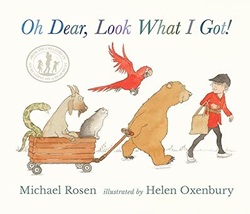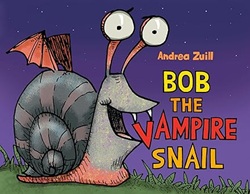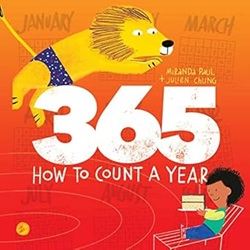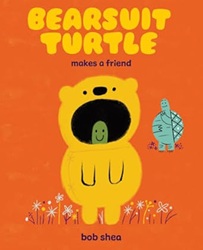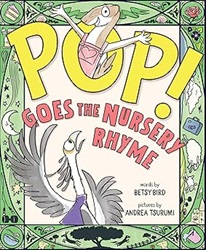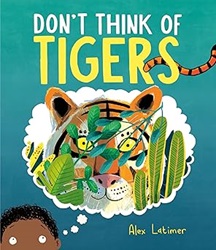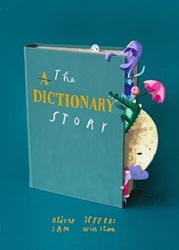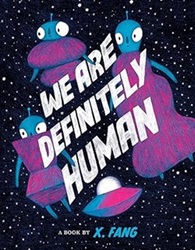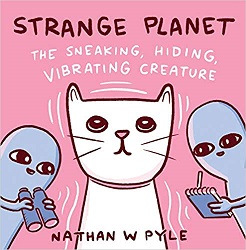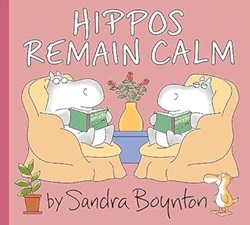 Hippos Remain Calm
Hippos Remain Calm
by Sandra Boynton
Boynton Bookworks (Simon & Schuster), 2023. 36 pages.
Review written January 3, 2024, from a library book.
Starred Review
I am so happy this book exists! Hippos Remain Calm is a sequel to Hippos Go Berserk, which was published in 1977, the very first book Sandra Boynton ever published!
I did not have a copy of Hippos Go Berserk, but a set of Sandra Boynton books were the first books I got for my first baby, born in 1988. To this day, I swear that her first word was “Ffffff!”, spoken when the Sandra Boynton book Doggies was pulled out. (A dog says “WOOF!” on every page.) Thus, my baby could read before she could even talk.
Anyway, Sandra Boynton’s concise genius is what makes her boardbooks great. Hippos Go Berserk is a counting book, featuring one hippo who invites two hippo friends over. More hippos join, and things get progressively more and more wild.
Hippos Remain Calm shows us the day of the peaceful hippo couple first invited to the party. A lot of eventful things happen in that day, but these hippos remain calm.
Here’s how the book begins:
Two fine hippos,
cozy at home,
take turns reciting
a morning-time poem.
“O, flare thy wild nostrils,
and welcome the day!”
“Onward! And upward!
Come what will, come what may.”
Then they wander outside
in the cool April weather.
“Hippo Morning to All!”
they call out together.
Things happen to the hippos – a sudden surprise snowstorm, persistently quacking ducks, and a ringing phone. The hippos remain calm. They practice slow breathing.
After they accept the invitation of their friend who doesn’t want to be alone, they have a lovely time together.
But wait. Is that a doorbell ring?
Are other hippos coming, too?
Uh-oh.
The Uh-oh spread has the scene of partying hippos — which I recently had the joy of completing in jigsaw puzzle form. This time, we can find our friends, the calm hippos who started the party.
We see them happily head home and then snooze all morning long.
Okay, this book doesn’t have quite the punch of the original. It’s not a counting book, so it won’t ever make the Mathical Book Prize Hall of Fame like the original.
But if you hear about wild hippos, why not read about calm ones? Families who have the first book will be delighted to find more to the story and look for the way the books are tied together. (There’s a helicopter flying off in the distance seen through the window on the final page, for example.)
Okay, and I enjoyed all that, and was already completely delighted with this book — and I just read the front flap and simply must repeat it here:
Hippos have somewhat of a reputation for wild parties that go on till dawn. People have even gone so far as to say that partying hippos “go berserk.” Nobody knows how these rumors got started.
But even if it’s true (it is), it’s not the whole story. Given the deep appreciation that hippos have for water, it’s no wonder that your average hippopotamus seeks, finds, and offers a state of flow, no matter the situation.
We have much to learn from their example. Accordingly, this helpful book follows two typical hippos as they calmly and mindfully go about their ordinary hippo day.
There you have it! Learn how to remain calm even when folks go berserk around you.
sandraboynton.com
Buy from Amazon.com
Find this review on Sonderbooks at: www.sonderbooks.com/Picture_Books/hippos_remain_calm.html
Disclosure: I am an Amazon Affiliate, and will earn a small percentage if you order a book on Amazon after clicking through from my site.
Disclaimer: I am a professional librarian, but the views expressed are solely my own, and in no way represent the official views of my employer or of any committee or group of which I am part.
What did you think of this book?
